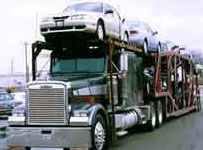Tuesday, March 3, 2009
Driving while impaired involving a CMV, particularly one transporting hazardous material, is a catastrophic event seeking a time and place to happen. Officers need to be constantly alert, both day and night, for actions and indicators such as driving too slowly, failing to stay within a single lane, careless/reckless driving, or any other behavior that would indicate the possibility of an impaired CMV driver. CMV drivers are considered impaired at 0.04 percent BAC. Officers should observe the actions of the driver during the initial vehicle stop for additional indicators of impairment. Other indicators to watch for are:
After the officer determines, based on the CMV driver's mental state, driving, physical appearance, and actions, that further investigation is necessary, standard field sobriety tests should be administered. Additionally, the officer needs to assess the possibility of a medical condition that may lead to reactions that mimic impairment (e.g., diabetic shock).
When the officer determines that there is sufficient probable cause to arrest a CMV driver for DWI, the procedures are the same as for any driver of any other type or class of motor vehicle. The statutes applicable to implied consent, chemical/breath testing, and the type and number of tests administered will determine the appropriate course of action the arresting officer should take.
In the event the officer cannot obtain sufficient evidence of DWI and the driver appears to act in a normal manner, a trained officer or certified CMV inspector should be summoned to the location. This officer can review the driver’s hours-of-service records and other related documents to determine if the erratic driving was the result of driver fatigue, perhaps caused by an hours-of-service infraction.
For more info: http://www.nhtsa.dot.gov/people/injury/enforce/cvm/CMV_targeting.html#turning:
- Driver's coordination when leaving the vehicle's cab.
- Open containers of alcoholic beverages in the cab. Containers may be brand name bottles or cans, or they can be plastic cups, thermos bottles, flasks, or plastic bottles with the labels removed. Agency policy should be followed to protect this type of evidence.
- Driver's appearance, including condition of clothes, breath odor, blood-shot or slow focusing eyes, confusion, and slurred speech.
- Manner and type of response to questions and directions.
After the officer determines, based on the CMV driver's mental state, driving, physical appearance, and actions, that further investigation is necessary, standard field sobriety tests should be administered. Additionally, the officer needs to assess the possibility of a medical condition that may lead to reactions that mimic impairment (e.g., diabetic shock).
When the officer determines that there is sufficient probable cause to arrest a CMV driver for DWI, the procedures are the same as for any driver of any other type or class of motor vehicle. The statutes applicable to implied consent, chemical/breath testing, and the type and number of tests administered will determine the appropriate course of action the arresting officer should take.
In the event the officer cannot obtain sufficient evidence of DWI and the driver appears to act in a normal manner, a trained officer or certified CMV inspector should be summoned to the location. This officer can review the driver’s hours-of-service records and other related documents to determine if the erratic driving was the result of driver fatigue, perhaps caused by an hours-of-service infraction.
For more info: http://www.nhtsa.dot.gov/people/injury/enforce/cvm/CMV_targeting.html#turning:
posted by transport blogs
@ 10:18 PM
permanent link | Post a Comment
|
![]()











0 Comments:
Post a Comment
<< Home